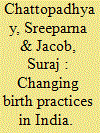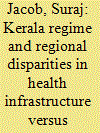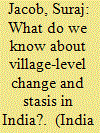| Srl | Item |
| 1 |
ID:
187121


|
|
|
|
|
| Summary/Abstract |
Institutional births increased in India from 39% to 79% between 2005 and 2015. Drawing from 17 months of fieldwork, this article traces the shift from home to hospital births across three generations in a hamlet in Assam in Northeast India. Here, too, one finds that most births have shifted from home to hospital in less than a decade, aided by multiple factors. These include ‘free’ birthing facilities and financial incentives offered by government schemes, idiosyncratic changes within the hamlet, such as the introduction of biomedical practices through home births where oxytocin was used, and changes in cultural belief systems among local people. The exploration reveals significant transitions between (and fluidities of) categories such as local/global, tradition/modernity, past/present and nature/technology, creating a complex and ambivalent narrative of change, in which the voices of mothers should not be ignored.
|
|
|
|
|
|
|
|
|
|
|
|
|
|
|
|
| 2 |
ID:
130007


|
|
|
|
|
| Publication |
2014.
|
| Summary/Abstract |
Conventional wisdom holds that although at the time of Kerala state formation in 1956 the northern region (Malabar) lagged behind the southern region (Travancore-Cochin) in development indicators, inter-regional disparities reduced considerably in ensuing decades. The reduction in regional disparities is typically attributed to modern Kerala's welfare policy regime, which emphasized greater growth of infrastructure facilities in Malabar. This study presents evidence for health that suggests that while disparities in outcomes reduced over time, disparities in key infrastructural inputs did not reduce. These differing trends for infrastructure and outcomes are consistentwith a diminishing returns argument that may have little to do directly with the Kerala regime. Rather, the potency of the Kerala regime lays in its ability to increase development inputs throughout the state (albeit without favoring the lagging region) and consolidate the conditions for "public action" to effectively demand and utilize these inputs.
|
|
|
|
|
|
|
|
|
|
|
|
|
|
|
|
| 3 |
ID:
142262


|
|
|
|
|
| Summary/Abstract |
The study documents considerable spatial variation in change and stasis in development outcomes over the decade from 2001 to 2011 (proxied by women’s literacy and child sex ratio) even across villages within the same micro-region (taluk or sub-taluk) and with similar starting points. However, neither decentralization policy / practice nor other forms of public policy has identified village-level factors that mediate the impact of policy. Although extant literature has explored spatial variation, it has not explored such variation across different micro-regions of India, nor has it used methodologies that validate explanatory inference from spatial-longitudinal comparisons. The article notes that the degree of spatial variation in change over such a short period of time is remarkably similar across different micro-regions of the country. It also proposes a tentative methodology for identifying village pairs to produce more rigorous comparative longitudinal analysis of the drivers of development change and stasis.
|
|
|
|
|
|
|
|
|
|
|
|
|
|
|
|